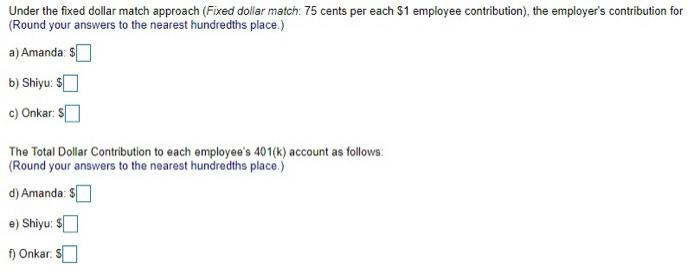Answered step by step
Verified Expert Solution
Question
1 Approved Answer
Calculating 401(k) Matching Contributions Companies decide whether to institute matching contributions. Ones that offer matching contributions do so for numerous reasons, including recruitment and


Calculating 401(k) Matching Contributions Companies decide whether to institute matching contributions. Ones that offer matching contributions do so for numerous reasons, including recruitment and retention of the most qualified individuals. Also, companies choose the formulas for making contributions and setting maximum limits. Here are three common approaches for determining matching contributions: Full match: The employer fully matches an employee's contribution to the 401(k) plan account up to an amount set by law. For illustrative purposes, an employee earning $50,000 annually contributes $2,000 to her 401(k). Then, the company's matching contribution equals $2,000. Fixed dollar match: The employer deposits $1 for every $1 the employee contributes up to a specified limit, for instance, 5 percent of pay. One employee contributes 3 percent of her $100,000 pay equaling $3,000: (3 percent x $100,000). The employer contributes the same amount. Another employee contributes 10 percent of his $100,000 pay equaling $10,000: (10 percent x $100,000). In this case, the company deposits $5,000: (5 percent x $100,000) because the plan specifies a 5 percent matching contribution maximum. Variable dollar match: The employer's contribution decreases as an employee's contribution increases. For example an employer might deposit $1 for every $1 on the first 3 percent of pay contributed by the employee, and 50 cents per dollar on the next 3 percent of pay. An employee who earns $100,000 annually contributes 6 percent to the 401(k) plan, equaling $6000: (6 percent x $100,000). The employer contributes a total of $4,500: [($1 x (3 percent x $100,000))+ ($0.50 (3 percent x $100,000))]. Now, let's calculate the employer's matching contributions for three employees, Amanda, Shiyu and Onkar using each method. Amanda earns $33,600 annually and does not contribute anything to the 401(k) plan. Shiyu earns $127,500 annually and contributes 5 percent of pay to the 401(k) plan. Onkar earns $83,200 annually and contributes 1 percent of pay. Under the fixed dollar match approach (Fixed dollar match: 75 cents per each $1 employee contribution), the employer's contribution for (Round your answers to the nearest hundredths place.) a) Amanda: $ b) Shiyu: S c) Onkar: S The Total Dollar Contribution to each employee's 401(k) account as follows: (Round your answers to the nearest hundredths place.) d) Amanda: S e) Shiyu: f) Onkar.
Step by Step Solution
★★★★★
3.45 Rating (181 Votes )
There are 3 Steps involved in it
Step: 1
SOLUTION FIRST LET US LOOK AT EACH EMPLOYEES EARNINGS AND HOW MUCH MONEY THEY CONTRIBUTE TOWARDS ...
Get Instant Access to Expert-Tailored Solutions
See step-by-step solutions with expert insights and AI powered tools for academic success
Step: 2

Step: 3

Ace Your Homework with AI
Get the answers you need in no time with our AI-driven, step-by-step assistance
Get Started


